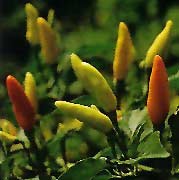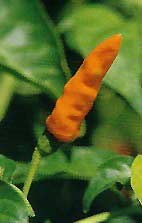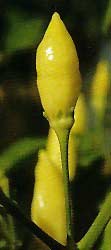By Dave DeWitt
Fiery Foods & BBQ Central Recommendations
Chile Pepper Bedding Plants… over 500 varieties from Cross Country Nurseries, shipping April to early-June. Fresh pods ship September and early October. Go here
Chile Pepper Seeds… from all over the world from the Chile Pepper Institute. Go here
Photos by Dave DeWitt and Harald Zoschke
Introduction

Tabasco Pods
The tabasco chile is the best known variety of this species, being the primary ingredient in the famous sauce that is now more than 135 years old. Another famous variety is the Malagueta, which grows semi-wild in the Amazon basin in Brazil, where the species probably originated. Curiously, there are not as many names for the wild varieties as there are for some other species. The most common name being “bird pepper.” No domesticated frutescens has ever been found in an archaeological site in Middle or South America, but ethnobotanists speculate the domestication site was probably Panama and from there it spread to South America, Mexico, and the Caribbean.
A Brief History
At any rate, we know the tabasco variety of frutescens was being cultivated near Tabasco, Mexico in the early 1840s because it was transferred to Louisiana in 1848, where it was eventually grown to produce Tabasco® Sauce. Demand outstripped supply, and today tabascos are commercially grown in Central America and Colombia and shipped in mash form to Louisiana.
In Louisiana, tabasco peppers fell victim to the tobacco etch virus, but were rescued in 1970 with the introduction of Greenleaf Tabasco, a TEV-resistant variety. Today at Avery Island, the site of the original tabasco growing and manufacturing operation, there are still fields of Tabasco under cultivation–but mostly for crop improvement and seed production.
An interesting botanical mystery crops up with the Malagueta pepper from Brazil because it has virtually the same name as the Malagueta pepper from West Africa. The mystery arises from the fact that the two peppers are completely unrelated botanically and in appearance. The African Malagueta (Aframomum Malagueta) is a reed-like plant with red berries, while the Brazilian Malagueta is very similar to the tabasco chile.

Malagueta Chile from Brazil
The Malagueta pepper enjoyed great popularity during the Elizabethan Age in England, primarily through trade with Portugal. Some food historians consider that since the word “Malagueta” was already a Portuguese term for spicy berry, this name was transferred to a Brazilian red chile pepper of even more pungency, sometime after the Portuguese settlement of Brazil. This scenario follows a pattern that Christopher Columbus began when he misnamed chiles as pepper. The chile peppers, it seems, were given the closest common name when they were “discovered” by Europeans. Interestingly enough, the African Malaguetas were eventually imported into Surinam and Guyana, where they were grown commercially. Some varieties of frutescens found their way to India and the Far East, where they are still called “bird pepper.” There they are cultivated to make hot sauces and curries.Botanical TraitsThe species name “frutescens” means shrubby or bushy. C. frutescens plants have a compact habit, an intermediate number of stems, and grow between 1 and 4 feet high, depending on climate and growing conditions. The leaves are ovate, smooth, and measure 2½ inches long and 2 inches wide.
The flowers have greenish-white corollas with no spots and purple anthers. The pods are borne erect and measure up to 1½ inches long and 3/8 inch wide. Immature pods are yellow or green, maturing to bright red. The frutescens species is quite hot, measuring between 30,000 and 50,000 Scoville Heat Units.
The height of the plants depends on climate, with the plants growing the largest in warmer parts of the country. The plant is particularly good for container gardening, and one of our specimens lived as a perennial for 4 years in a pot, but gradually lost vigor and produced fewer pods each year. A single plant can produce 100 or more pods.
Pod Variation
The species C. frutescens and C. pubescens have fewer pod shapes, sizes, and colors than C. annuum, C. chinense and C. baccatum. No one knows the real reason for this. One must remember that the diversity of pod morphology is human-guided. In other words, the differences one sees in pod size and shape are because humans conscientiously made choices on which pods to save for the next growing season. In nature, wild chile plants usually have small red, erect fruits that drop off easily. The small fruit and easy fruit drop traits are beneficial for bird dispersal. However, humans prefer large fruit and fruit that stays attached to the plant until harvested. Thus, under domestication these traits are modified.

‘Angkor Sunrise’ frutescens from Cambodia
The C. frutescens plant has small fruits that drop off easily. Therefore, an explanation for the lack of fruit shapes in C. frutescens is that it is still mostly a ild form. It is found growing in the same areas as C. annuum and C. chinense, so selection may have been on C. annuum and C. chinense, while C. frutescens had little or no selection.
Culinary Use
The most common use for the pods is making hot sauces; they are crushed, salted, fermented, and combined with vinegar. However, the pods can be used fresh in salsas and can be dried for adding to stir-fry dishes.





